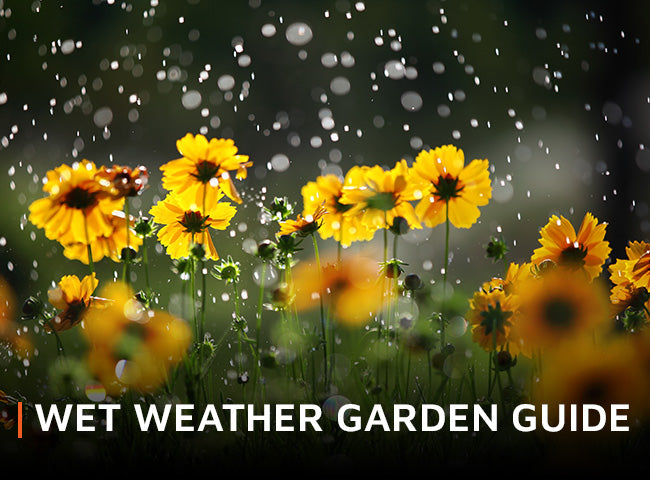Gardening in the UK can be tough. Bad weather and fluctuating temperatures often lead to difficult growing conditions. And with spring being the prime growing time, heavy April showers can be the bane of gardener’s lives.
Once flowers have been battered by frequent rain, restoration takes time and effort. Even your hardiest perennials can be affected. However, all is not lost. Here are some ways to prepare for the wet weather, and keep your plants alive over the rainy season.
Waterlogging

Image source: Carmina McConnell
It’s a frustrating scenario for any gardener. After a heavy rainfall, spots occur in your garden where water remains in puddles and doesn’t drain away. This is a common problem, but one that really harms your plants.
Waterlogging happens when water clogs up air pockets that are naturally found in soil. Oxygen struggles to reach the roots, and without this, the soil stagnates and the roots can’t grow properly.
The symptoms of waterlogging

Image source: Jurga Jot
Spotting the outward symptoms of waterlogging is the first step to fixing the problem. The obvious sign is the soil is wet with surface puddles that won’t drain away.
Ironically, if your plants are waterlogged, they’ll look like they need watering. Yellowing leaves, drooping stems and dropping leaves are classic signs. But, don’t be deceived. This appearance is due to oxygen not reaching the roots.
Under the soil, the plant may well be starting to decompose. If that’s the case, and you pull the plant out, the roots will be black, soft and have a decaying smell.
Treating a waterlogged area

Image source: Torychemistry
If your soil’s already waterlogged, there are steps to limit further damage. Avoid walking on this soil, as this compacts the earth and can make the problem worse. Remove any dead or dying plants as they can carry disease. Put these plants straight in the bin, and not in your compost heap.
You can save plants that are still alive in waterlogged soil, though.
Move these plants to a spot with better drainage, or into a separate plant pot. Remember to be careful, as these plants will be more fragile than normal. Make sure you place the plant in fresh compost and soil, and double check that there’s adequate drainage.
Prevention

Image source: shutterstock
Hate what waterlogging does to your garden? We don’t blame you. Now’s the time to prepare your garden for the next rainfall. There are a few crucial techniques that will assist you in your flood prevention.
Mulch

Image source: Miriam Doerr Martin Frommherz
Adding mulch is a important step for combating excess water. This type of ground covering is useful in absorbing moisture, along with suppressing weeds.
Buy mulch from garden centres, or make it up from organic materials like straw, tree bark or wood chippings. Add a generous layer to your flower beds, particularly around the base of the plants.
Spike

Image source: Simon Kadula
It’s time to spike! Spiking or pricking your garden is exactly what it says. By making holes in the soil with a garden fork (or specialised equipment), you open out the waterlogged air pockets and thus ventilate your garden. The deeper you can spike, the better for your garden.
If you’ve got a waterlog-prone garden, you’ll have to spike frequently.
Raised Beds and Wooden Frames

Image source: Jamie Hooper
Another thing you can do is invest in raised beds or growing frames. These are great in ensuring your plants aren’t badly damaged by heavy rainfall.
These beds should have adequate drainage if installed correctly. Raised beds are ideal if you live in an area of thick clay soil which is prone to waterlogging, as you can fill the bed with good quality topsoil and compost.

Feature Image: Garden Grow Wooden Cold Frame from Waltons
Alternatively, invest in cold frames.These growers are designed specifically for cold or wet weather, so they’re ideal for delicate or young plants. In the right position, protected from the worst of the elements, you can rest assured that your plants will remain safe during heavy rainfall.
With these simple preventative measures, you can help protect plants against heavy downpours and the resulting waterlogging. UK weather is very unpredictable and can cause chaos for gardeners. So save yourself the stress and heartache, and get your garden protected!
If you’ve got any further tips for keeping your garden wet-weather ready, we’d love to hear them over on our Facebook page.
Lead image: Shutterstock




